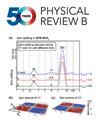Electric field gradients at the nuclei from all-electron four-component relativistic density functional theory using Gaussian-type orbitals
IF 3.7
2区 物理与天体物理
Q1 Physics and Astronomy
引用次数: 0
Abstract
We present an all-electron, four-component relativistic implementation of electric field gradients (EFGs) at the nuclei using Gaussian-type orbitals and periodic boundary conditions. This allows us to include relativistic effects variationally, which is important for compounds containing heavy elements and for a property dependent on the electronic structure close to the nuclei. The all-electron approach ensures an accurate treatment of both core and valence orbitals, as both are important in the evaluation of EFGs. Computational efficiency is achieved through the use of a recent implementation of density fitting in combination with quaternion algebra and restricted kinetic balance. We use the relativistic approach to calculate the EFGs in different arsenic, antimony, and bismuth halides and oxyhalides, and explore the importance of relativistic effects on EFGs in solids and compare these with results obtained for molecular species. Our calculations contribute to establishing a reliable estimate for the nuclear quadrupole moment of , for which our best estimate is mb, in excellent agreement both with molecular data and a recent reevaluation of the nuclear quadrupole moment obtained from atomic data and ab initio calculations. Our results suggest that there is a need to revisit the experimental data for the EFGs of several bismuth oxyhalides.利用高斯型轨道的全电子四分量相对论密度泛函理论得出的原子核处的电场梯度
我们利用高斯型轨道和周期性边界条件,提出了原子核处电场梯度(EFGs)的全电子四分量相对论实现方法。这使我们能够将相对论效应变化纳入其中,这对于含有重元素的化合物和依赖于靠近原子核的电子结构的性质非常重要。全电子方法确保了对核轨道和价轨道的精确处理,因为这两种轨道在 EFG 评估中都很重要。通过使用最新实现的密度拟合,结合四元数代数和受限动力学平衡,实现了计算效率。我们使用相对论方法计算了不同砷、锑和铋卤化物和氧卤化物中的 EFGs,探讨了相对论效应对固体中 EFGs 的重要性,并将其与分子物种的计算结果进行了比较。我们的计算有助于为 Bi209 的核四极矩建立一个可靠的估计值,我们的最佳估计值为-428(17) mb,这与分子数据以及最近从原子数据和 ab initio 计算中获得的核四极矩的重新评估结果非常一致。我们的结果表明,有必要重新审视几种氧卤化铋的 EFG 的实验数据。
本文章由计算机程序翻译,如有差异,请以英文原文为准。
求助全文
约1分钟内获得全文
求助全文
来源期刊

Physical Review B
物理-物理:凝聚态物理
CiteScore
6.70
自引率
32.40%
发文量
0
审稿时长
3.0 months
期刊介绍:
Physical Review B (PRB) is the world’s largest dedicated physics journal, publishing approximately 100 new, high-quality papers each week. The most highly cited journal in condensed matter physics, PRB provides outstanding depth and breadth of coverage, combined with unrivaled context and background for ongoing research by scientists worldwide.
PRB covers the full range of condensed matter, materials physics, and related subfields, including:
-Structure and phase transitions
-Ferroelectrics and multiferroics
-Disordered systems and alloys
-Magnetism
-Superconductivity
-Electronic structure, photonics, and metamaterials
-Semiconductors and mesoscopic systems
-Surfaces, nanoscience, and two-dimensional materials
-Topological states of matter
 求助内容:
求助内容: 应助结果提醒方式:
应助结果提醒方式:


